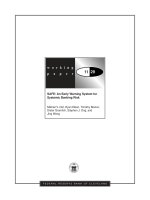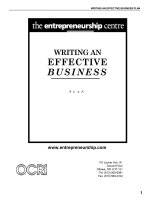assessing financial vulnerability an early warning system for emerging markets phần 1 ppt
Bạn đang xem bản rút gọn của tài liệu. Xem và tải ngay bản đầy đủ của tài liệu tại đây (518.65 KB, 12 trang )
1
1
Introduction
This study analyzes and provides empirical tests of early warning indica-
tors of banking and currency crises in emerging economies. The aim is
to identify key empirical regularities in the run-up to banking and cur-
rency crises that would enable officials and private market participants
to recognize vulnerability to financial crises at an earlier stage. This, in
turn, should make it easier to motivate the corrective policy actions that
would prevent such crises from actually taking place. Interest in identify-
ing early warning indicators of financial crises has soared of late, stoked
primarily by two factors: the high cost to countries in the throes of crisis
and an increasing awareness of the insufficiency of the most closely
watched market indicators.
There is increasing recognition that banking and currency crises can
be extremely costly to the countries in which they originate. In addition,
these crises often spill over via a variety of channels to increase the
vulnerability of other countries to financial crisis.
According to one recent study, there have been more than 65 develop-
ing-country episodes during 1980-95, when the banking system’s capital
was completely or nearly exhausted;
1
the public-sector bailout costs of
resolving banking crises in developing countries during this period have
1. See Caprio and Klingebiel (1996b). Other identifications of banking crises over this period
can be found in Demirgu
¨
c
¸
-Kunt and Detragiache (1998), Eichengreen and Rose (1998), IMF
(1998c), Kaminsky and Reinhart (1999), and Lindgren et al. (1996).
Institute for International Economics |
2 ASSESSING FINANCIAL VULNERABILITY
been estimated at around $250 billion.
2
In more than a dozen of these
banking crises, the public-sector resolution costs amounted to 10 percent
or more of the country’s GDP.
3
In the latest additions to the list of severe
banking crises, the cost of bank recapitalization for the countries most
affected in the ongoing Asian financial crisis is expected to be huge—on
the order of 58 percent of GDP for Indonesia, 30 percent for Thailand, 16
percent for South Korea, and 10 percent of GDP for Malaysia (World
Bank 2000).
In addition to the enormous fiscal costs, banking crises exacerbate
declines in economic activity, prevent national saving from flowing to its
most productive use, limit the room for maneuver in the conduct of
domestic monetary policy, and increase the chances of a currency crisis
as well (Lindgren, Garcia, and Saal 1996; Goldstein and Turner 1996).
Illustrative of the magnitude of output losses, an International Monetary
Fund study (IMF 1998c), drawing on a sample of 31 developing countries,
reported that it typically takes almost three years for output growth to
return to trend after the outbreak of a banking crisis and that the cumula-
tive output loss averaged 12 percent.
4
Probably the main reason Mexican
authorities did not make more aggressive use of interest rate policy after
the assassination ofpresidential candidate LuisDonaldo Colosio inMarch
1994 is that bad loan problems in the banking system had by then already
become serious, and they were worried that recourse to higher interest
rates would push Mexican banks over the edge. Yet failure to increase
domestic interest rates in the face of international investors’ rising concern
contributed to a rapid decline in international reserves and helped to
transform a banking problem into a currency and debt crisis (Calvo and
Goldstein 1996). This pattern in the timing of the banking and currency
crises is not unique to the Mexican case. Drawing on a broader sample
of banking and currency crises in emerging economies, there is evidence
that the onset of a banking crisis typically precedes a currency crash
(Kaminsky and Reinhart 1999; IMF 1998a).
5
2. This figure is net of the estimated amount of loans that were eventually repaid. See
Honohan (1997).
3. See Goldstein (1997) for a list of these severe banking crises. For comparison, the public-
sector tab for the US saving and loan crisis is typically estimated at about 2 to 3 percent of
US GDP.
4. In chapter 7, we present our own estimates of how long it takes growth rates of real
output to recover after banking and/or currency crises.
5. In chapter 3, we provide further evidence that the presence of a banking crisis is one of
the better leading indicators of a currency crisis in emerging economies. At the same time,
the evidence also suggests that a currency crash aggravates the problems in the banking
sector, as the peak of a banking crisis most often occurs following the collapse of the
currency. The dating of currency and banking crises is discussed in detail in chapter 2.
Institute for International Economics |
INTRODUCTION 3
Table 1.1 Emerging Asia: real GDP growth forecasts, 1996-98
1998 Actual
Country 1996 1997 (as of May 1997) 1998
Indonesia 7.8 4.9 7.5 מ13.7
Thailand 6.4 מ1.3 7.0 מ8.0
South Korea 7.1 5.0 6.3 מ5.8
Malaysia 8.6 7.8 7.9 מ6.7
The Philippines 5.7 5.1 6.4 מ0.5
Hong Kong 4.9 5.3 5.5 מ5.1
Source: International Monetary Fund, World Economic Outlook.
Although the contagion of financial disturbances usually runs from
large countries to smaller ones, the Asian financial crisis has shown that
severe financial-sector difficulties in even a relatively small economy
(namely Thailand) can have wide-ranging spillover effects if it acts as a
‘‘wake-up call’’ for investors to reassess country risk and if a set of other
economies have vulnerabilities similar to those in the economy first
affected.
6
The costs of currency crises have likewise been shown to be significant
both in terms of reserve losses and output declines (see chapter 7). During
the Exchange Rate Mechanism (ERM)crises of the fall of 1992 andsummer
of 1993, about $150 billion to $200 billion was spent on official exchange-
market intervention in a fruitless effort to stave off the devaluation and/or
floating of ERM currencies. Mexico’s peso crisis was accompanied in 1995
by a decline in real GDP of 6 percent—its deepest recession in 60 years.
In emerging Asia, consensus forecasts for 1998 growth issued just before
the crisis (that is, in May-June 1997) generally stood in the 6 to 8 percent
range. As indicated in table 1.1, these forecasts were subject to unprece-
dented downward revisions in the midst of the currency, banking, and
debt crises enveloping these economies. The IMF (1998c) estimates that
emerging economies suffer, on average, an 8 percent cumulative loss in
real output (relative to trend) during a severe currency crisis. And like
banking crises, currency crises seem contagious. One recent study found
that a currency crisis elsewhere in the world increases the probability of a
speculative attack by an economically and statistically significant amount
even after controlling for economic and political fundamentals in the
country concerned (Eichengreen, Rose, and Wyplosz 1996; see also Calvo
and Reinhart 1996; Kaminsky and Reinhart 2000).
The more costly it is to clean up after a financial crisis, the greater the
returns to designing a well-functioning early warning system.
6. See Calvo and Reinhart (1996) and Goldstein (1998a). Kaminsky and Reinhart (2000)
provide an analysis of contagion in the Asian crisis that stresses the financial links among
these countries—including the sudden withdrawal of funds by a common commercial bank
lender or mutual fund investor. See also chapter 6.
Institute for International Economics |
4
Table 1.2 Rating agencies’ performance before the Asian crisis: Moody’s and Standard & Poor’s long-term debt
ratings,
a
1996-97
15 January 1996 2 December 1996 24 June 1997 12 December 1997
Rating Outlook Rating Outlook Rating Outlook Rating Outlook
Moody’s foreign currency debt
Indonesia Baa3 Baa3 Baa3 Baa3
Malaysia A1 A1 A1 A1
Mexico Ba2 Ba2 Ba2 Ba2
The Philippines Ba2 Ba2 Ba2 Ba2
South Korea A1 A1 stable Baa2 negative
Thailand A2 A2 A2 Baa1 negative
Standard & Poor’s October 1997
Indonesia
Foreign currency debt BBB stable BBB stable BBB stable BBB negative
Domestic currency debt Aם Aם Aמ negative
Malaysia
Foreign currency debt Aם stable Aם stable Aם positive Aם negative
Domestic currency debt AAם AAם AAם AAם negative
Institute for International Economics |
5
Mexico
Foreign currency debt BB negative BB BB
Domestic currency debt BBBם BBBם stable BBBם positive
The Philippines
Foreign currency debt BB positive BB positive BBם positive BBם stable
Domestic currency debt BBBם BBBם Aמ Aמ stable
South Korea
Foreign currency debt AAמ stable AAמ stable
Domestic currency debt
Thailand
Foreign currency debt A stable A stable A stable BBB negative
Domestic currency debt AA AA A negative
a. From highest to lowest, Moody’s rating system includes Aaa, Aa1, Aa2, Aa3, A1, A2, A3, Baa1, Baa2, Baa3, Ba1, Ba2, and Ba3, and Standard &
Poor’s runs AAA, AAם, AA, AAמ,Aם,A,Aמ, BBBם, BBB, BBBמ,BBם, BB, and BBמ.
Source: Radelet and Sachs (1998).
Institute for International Economics |
6 ASSESSING FINANCIAL VULNERABILITY
The second reason for the increased interest in early warning indicators
of financial crises is that there is accumulating evidence that two of the
most closely watched ‘‘market indicators’’ of default and currency risks—
namely, interest rate spreads and changes in credit ratings—frequently
do not provide much advance warning of currency and banking crises
(see chapter 4).
Empirical studies of the 1992-93 ERM crisis have typically concluded
that market measures of currency risk did not raise the specter of signifi-
cant devaluations of the weaker ERM currencies before the fact (Rose and
Svensson 1994). Another study, encompassing a larger number of crisis
episodes, similarly concluded that the currency forecasts culled from
survey data are useless in anticipating the crises (Goldfajn and Valde
´
s
1998). In the run-up to the Mexican crisis, market signals were again
muted or inconsistent. More specifically, measures of default risk on
tesobonos (dollar indexed, Mexican government securities) jumped up
sharply in April 1994 (after the Colosio assassination) but stayed roughly
constant between then and the outbreak of the crisis (Leiderman and
Thorne 1996; Obstfeld and Rogoff 1995). From April 1994 on, market
expectations of currency depreciation on the peso usually were beyond
the government’s announced rate; nevertheless, this measure of currency
risk fluctuated markedly. The gap between market expectations and the
official rate was widest in summer of 1994, but the attack came with most
ferocity only in late December (Obstfeld and Rogoff 1995; Leiderman and
Thorne 1996; Rosenberg 1998).
The evidence now available suggests that the performance of interest
spreads and credit ratings was likewise disappointing in the run-up to
the Asian financial crisis. Examining interest rate spreads on three-month
offshore securities, one study found that these spreads gave no warning
of impending difficulties (i.e., were either flat or declining) for Indonesia,
Malaysia, and the Philippines and produced only intermittent signals for
Thailand (Eschweiler 1997b). A recent analysis of spreads using local
interest rates for South Korea, Thailand, and Malaysia similarly found
little indication of growing crisis vulnerability (Rosenberg 1998).
Sovereign credit ratings (on long-term, foreign-currency debt) issued
by the two largest international ratings firms were even less prescient in
the Asian crisis (see chapter 4, as well as Radelet and Sachs 1998; Goldstein
1998c).
7
As shown in table 1.2, there were almost no downgrades for the
7. In a recent report, Moody’s (1998) argues that its rating record in the East Asian crisis
was better than it appears at first sight from ratings changes alone. More specifically, the
report argues, inter alia, that Moody’s went into the crisis with lower ratings for the crisis
countries than the other major ratings agencies (i.e., Standard & Poor’s and Fitch-IBCA),
that it took ratings actions before its main competitors, that its low bank financial strength
ratings identified many of the banks that subsequently experienced stress in the crisis
countries, that changes in sovereign credit ratings led to a widening of yield spreads in the
crisis countries, and that one should examine the sovereign research reports—not just the
Institute for International Economics |
INTRODUCTION 7
most severely affected countries in the 18-month run-up to the crisis. As
The Economist (13 December 1997, p. 68) put it, ‘‘[I]n country after country,
it has often been the case of too little, too late.’’ Looking at a larger sample
of cases, a recent study by the Organization for Economic Cooperation
and Development (OECD) was unable to find consistent support for the
proposition that sovereign credit ratings act more like a leading than a
lagging indicator of market prices (that is, of interest rate spreads; see
Larraı
´
n, Reisen, and von Maltzan 1997).
Furthermore, international organizations such as the IMF did not do
better than the rating agencies in anticipating several of the recent crises.
A recent external evaluation of IMF surveillance concludes:
We found that the Fund—in both bilateral and multilateral surveillance—largely
failed to identify the vulnerabilities of the countries that subsequently found
themselves at the center of the Asian financial crisis, except in the case of Thailand.
In particular, it failed until rather late in the day to address a number of systemic
issues. Moreover, to the extent that surveillance did identify these vulnerabilities,
the tone of published Fund documents—notably [the World Economic Outlook]—
was excessively bland prior to the December 1997 update of WEO [and the
International Capital Markets Report], after the crisis had erupted. (IMF 1999, 56)
There are, of course, several reasons interest rate spreads or changes
in sovereign credit ratings may not anticipate financial crises well.
8
For
one thing, market participants may not have timely, accurate, and compre-
hensive information on the borrower’s creditworthiness. Several recent
examples underscore the point (see also Goldstein 1998a; Corsetti, Pesenti,
and Roubini 1998; BIS 1998). Thailand’s commitments in the forward
exchange market and South Korea’s lending of international reserves to
commercial banks meant that official figures on gross international
reserves gave a misleading (i.e., overoptimistic) view of each country’s net
usable reserves. Similarly, external foreign-currency denominated debt of
Indonesian corporations, along with nonperforming bank loans in South
Korea, Thailand, Malaysia, and Indonesia, turned out to be considerably
larger than precrisis published official data suggested. Ceteris paribus,
one could conjecture that if the true size of liquid assets and liabilities
were known at an earlier stage, interest rate spreads would have been
higher and credit ratings would have been lower than actually observed
before the Asian crisis; this in turn could well have moderated the sharp
ratings—in looking for early warning signals. At the same time, the report acknowledges
that the firm is studying several potential enhancements to its analytical methodology to
help improve the predictive power of its sovereign ratings.
8. It is sometimes also argued that even when credit rating agencies or international financial
organizations (such as the IMF) conclude that crisis vulnerability is high, they will be
reluctant to go ‘‘public’’ with a downgrade or a warning for fear of being accused of
precipitating the crisis.
Institute for International Economics |









